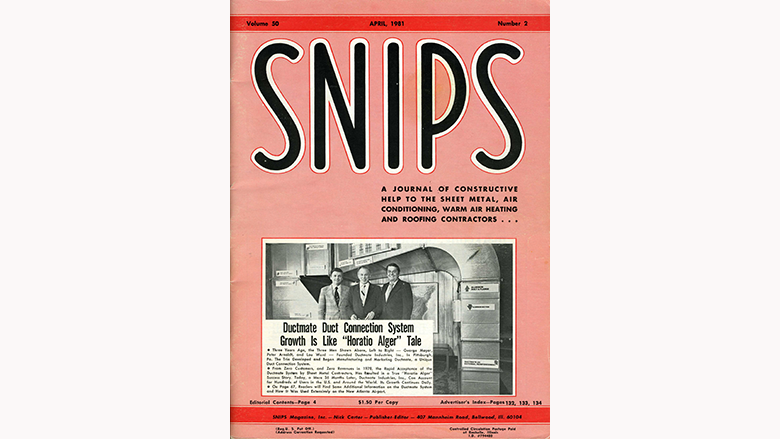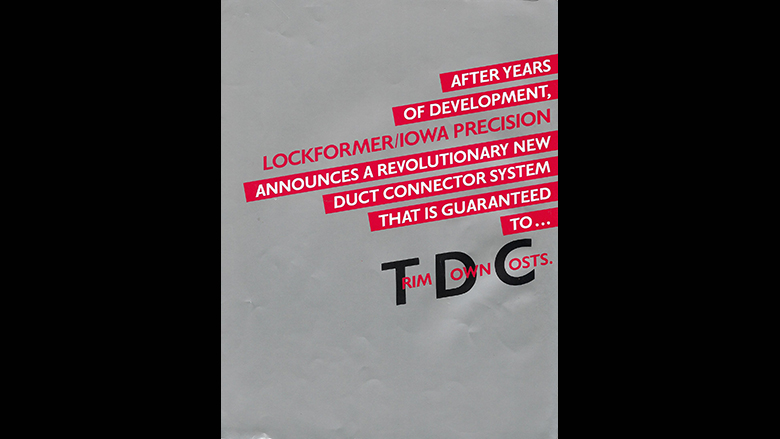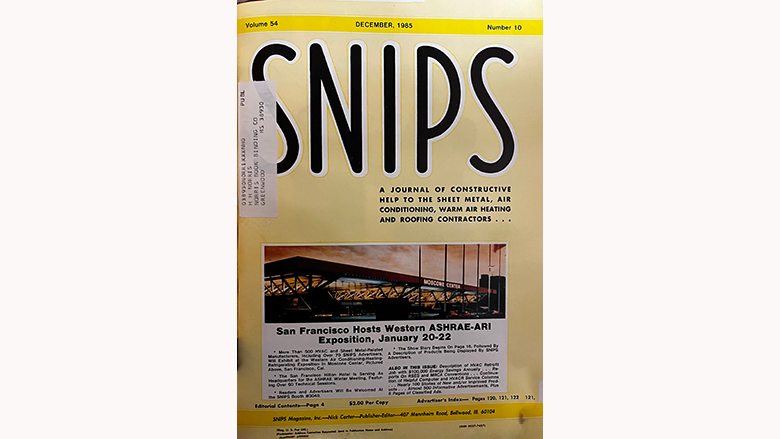In my opinion, the ‘80s saw the most significant development in HVAC duct fabrication of any during the past half-century. So much so, that I have to split the 1980s into two stories: One is in the March issue of SNIPS hereto, and another is due to be published in the April issue. I covered the ‘70s in a previous issue.
Rectangular Transverse Connections (joints)As the late ‘70s closed out there were many different types of connections. Some were regional, others were constructed to contractor preferences regarding time to shop fabricate and for field hanging:
- Standing Drive Slip
- Standing S (seam)
- Flat S & D (slip & drive)
- Pocket lock of Government lock
- Companion angle/Welded companion flange
- New England and New York locks
I’m sure there are others as well. Many were flat spec’d by the mechanical engineer and/or written into government specifications. And then came the introduction of what is generically called: The “Slide-On Four Bolt Connector” and “Rolled-On Connector.” Ductmate was not the first slide-on manufacturer, but the first company to introduce into the North American market. Its origin was Europe, specifically, Germany.
During my first European business trip for Gripnail in 1973, I saw the “MEZ” four-bolt system in use. It was developed by George Mez. Other similar systems followed. But I didn’t comprehend the significance. After Ductmate brought it to the U.S. in 1977, the four-bolt connection systems would eventually change how duct is fabricated world-wide.
One of the “other” European designs was Schmidtka, another German company. In 1977, representatives visited with Canadian steel companies due to the “flange” being made of, well, steel. As I’ve been told, the steel companies didn’t know its value or how to market if it had potential, but they had a mechanical engineer whom they had worked with: Peter Arnoldt. Peter knew George Mayer, who knew Lou Ward, a past president of the Sheet Metal and Air Conditioning Contractors' National Association and owner of Crest Air in Pittsburgh. This brought together all the ingredients needed to launch what became known as Ductmate. Specifically: Crest Air, a sheet metal contractor based in Pittsburgh and signatory to SMWIA Local 12, allowed Ductmate to use the union yellow label on all products.
But first, they worked out a deal to purchase two containers of the Schmidtka flange and corners and shipped to the U.S. Technically, the first Ductmate product to enter the North American market was a Schmitka product: Ductmate named it DM35. The 35 stands for 35mm, which is standard industry-wide, including all Rolled-On flange that arrived later.
What Ductmate brought to the table was innovation. Peter, the engineer, changed the “pocket” design to accept a hot-melt sealant where the duct wall meets the flange and redesigned the corner to give a virtual leak-proof system – timing couldn’t have been better.
In 1979, the Iranian revolution spiked energy prices. Hence, with duct leakage in U.S. buildings being a serious contributor to energy use, the industry began to tighten up this leakage – an effort which continues today. I remember Mel Wind, owner of Peabody and Wind, a large Philadelphia contractor, told me 25% duct leakage rates were not an exaggeration. Four-Bolt Connectors were a natural way to reduce the transverse leakage.
“In response to the energy crisis, the mechanical engineering fraternity developed what is known as variable air volume systems (VAV),” says George Mayer, who sold his ownership stake in Ductmate in 1981 to retire. “It was an entirely new concept, where it was intolerable to have leakage because the systems were over-designed to compensate for that leakage."
The unique partnership between Mayer, Arnoldt and Ward that formed Ductmate came together at a perfect time.
“In very short order, we had competitors – starting off with people we trained,” Mayer says, referencing employees like myself who began to saturate the market with companies like Quikduc. But of the early four four-bolt connector companies that emerged in the ‘70s and ‘80s, only one remains today after various mergers and acquisitions: Ductmate.



My Contribution to the HVAC Sheet Metal Industry
In 1978, I resigned from Gripnail due to differences with the direction the owner was taking the company. He thought Gripnail had more potential outside the HVAC industry. Obviously, I didn’t. So, there is a two year gap in my half century-long story, but before resigning, I attended the fall 1977 SMACNA Annual Convention in Las Vegas.
This was the second trade show since establishing the Associate Membership. At the SMACNA trade show, Peter, Lou and George were there showing the Schmidtka system. Major contractors like Cavet Synder, President of D/C based Stromberg Sheet Metal and ex SMACNA President; Mel Wind; Mose Waldinger, President of Des Moines based Waldinger Corp.; and other leading-edge U.S. sheet metal contractors were all enthralled with the product. Since I knew most and respected these trend-setting contractors, I had to get involved.
During my two-year industry absence, I relocated to Southern California in 1979. Shop Superintendent at Waldinger George Hinshaw (more about him later and how he helped develop TDC) suggested I contact George Mayer at Ductmate; that he felt I could help them out. I took over the Southern California market as a Ductmate rep on January 1, 1980, helping the company grow market share for 14 months before being terminated by George (long story).
Getting a contractor to switch from existing methods of transverse connections to Ductmate was one of the most difficult industry tasks I ever encountered. Though I knew the industry and my way around, most of my efforts were in developing shop-related, labor-saving machinery. Nothing prepared me for calling on contractors as a Ductmate rep.
SoCal contractors used, almost exclusively, what the West Coast called the Government Lock, or Pocket Lock. It was made in shop from excess scrap, basically free material with little labor. Ductmate was a “purchased” product, costing at that time around $2 per foot. But that was not the killer to a sale. It burdened the shop with about twenty minutes to install on both ends of the duct. So, to sell this product, one had to convince the contractor to start buying his connector and increasing his shop labor 20 minutes per joint. For the first few months of 1980, I was shown the door more than once. And these contractors were using Gripnail – which I sold years prior.
Now, some jobs were easy. Where companion flange was either preferred or spec’d, it was a no-brainer, but those jobs were rare. The real money was with riser shafts and floor “loops.” What I and many others didn’t appreciate was the magnitude of field-hanging labor-savings, on the job site. It was on an eight story El Segundo office building where the field foreman and I had worked out a “trial” that taught me how to sell a four-bolt connector and the potential it had. What the foreman estimated it would take him to hang and seal a Government Lock (8) story riser (five days) he did in two using Ductmate.
“There were superintendents that didn’t want the 20% labor increase in the shop, even though in the field, it saved 50% on labor,” George says, adding that he needed a “tenacious bulldog” to convince large contractors to become prime users of Ductmate.
Conflicts between shop and field issues always arise. The four-bolt connector is the perfect football. But what it brings to the table is not only the fastest method for hanging duct; it eliminates secondary sealing of the transverse joint which every connection requires.
After my short tenure at Ductmate, due to my past ten years at Gripnail and industry contacts along with what I had learned about Four Bold connectors, I knew I had all the knowledge I needed to go into competition with Ductmate. And because of my respect for Duro-Dyne, I contacted Milt Hinden, suggesting we team up to go after them. But by late spring of 1981, he turned me down. Two years later, after George sold his stake, Lou Ward left and started WDCI. Ductmate struggled financially and both were vulnerable to serious competition, such as from Duro-Dyne. I’ve often wondered what the industry today would look like had Milt accepted my offer in the Spring of 1981 – it was 20 years later that Duro-Dyne finally entered the slide-on connector business.
In many cases, the strength of a Ductmate-type flange is overkill, particularly on loops. It was only a matter of time before another system using “four bolts” would be conceived: the “Rolled-On Connection.”
I joined forces with Art Vlastnik who quit his job as Lockformer’s West Coast rep to enter the competition as Quikduc. Naturally, we approached Lockformer, but found out that a new system was being developed by Lockformer and Welty-Way (now Iowa Precision) working with George Hinshaw at Waldinger. What followed was the 1982 introduction of Lockformer’s TDC (Transverse Duct Connection), soon copied by Engel Industries TDF (Transvers Duct Flange) – both generically referred to now as “Rolled-On Connectors.” As with the Slide-On Connectors, the TDC had its genesis in Europe, specifically, the UK.
Howard McElroy, IPI’s chief engineer, was in the UK and saw how contractors there were using a press to bend a flange channel at the transverse joint; then adding crude corners welded or pop-riveted in to make a transverse connection. Back in the U.S., he teamed up with Lockformer to “roll-form” the flange channel on both ends of the duct while the duct is being fabricated in IPI’s FabriDuct (coil-line). Hence, the shop labor associated with using a Slide-On connector, along with the cost, was virtually eliminated: a “free” transverse joint – shop-made except for the corners.
Automating corner attachment would come later. This was not in Ductmate’s or any other Slide-On connector’s best interest, including Quikduc. But at the same time, I could see the writing on the wall.
Single-station TDC and TDF machines companioned with duct lines for fabricating fittings. Now, the system was complete, other than test data to meet SMACNA’s DCS for engineering acceptance. In many places, the strength of a Slide-On connector is not needed, such as loops. Therefore, a contractor switching to Rolled-On flange construction could get labor and material savings in shop while enjoying the benefits of reduced field labor along with a tight joint.
Forty years later, the four-bolt connector systems (both Rolled-On and Slide-On) have basically eliminated all other transverse connection systems – not only in the North American market, but world-wide. If anyone had every predicted to me when I first saw four-bolt systems in Europe in 1973 and again at SMACNA in 1977 that they would be the only viable systems today, I would have recommended psychiatric care.


Report Abusive Comment